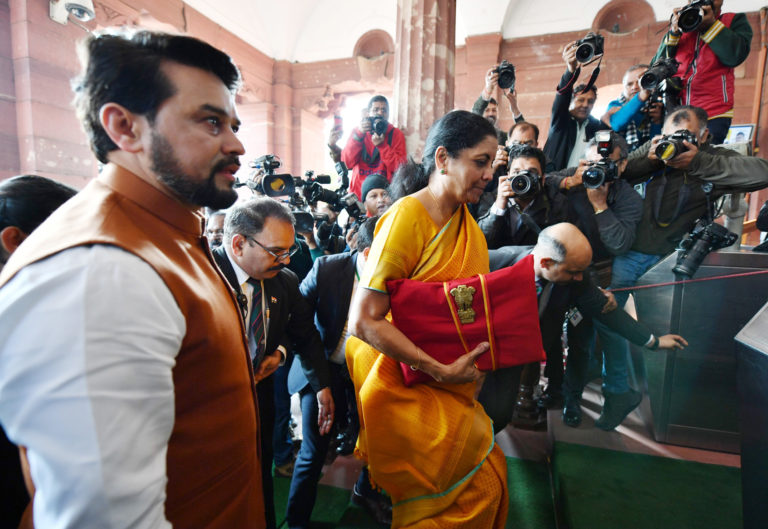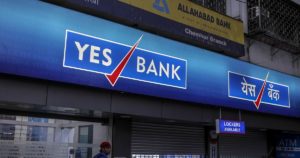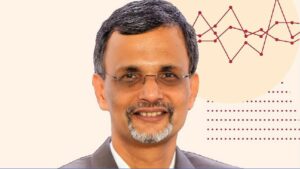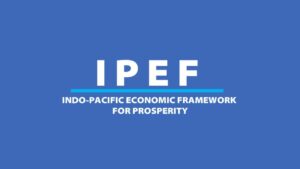Union Finanace Minister Nirmala Sitharaman started her Budget speech by paying homage to former Finance Minister Arun Jaitley, who cleared Indian roads and highways by throwing the octroi check posts and barriers into the Arabian Sea and broke the nexus between small-time politicians and government officials by implementing the much-needed tax reform in the form of GST. The move added 60 lakh new taxpayers to the system and 40 crore returns were filed.
She said her budget aims to address hopes and aspirations of all the sectors and centres around three ideas — Aspirational India, Economic development, A Caring Society. When the economy is reeling under a sharp slowdown, Finance Minister Nirmala Sitharaman has delivered a growth oriented and pragmatic budget. She has taken enough steps to increase demand in the economy, especially in semi-urban and rural India. However, the first impression it provided was, it is not a capital market friendly budget.
Market participants didn’t like her announcements and a disappointed market crashed badly on Saturday. Investors lost nearly Rs 3.6 lakh crore of wealth in a single day. Now Nifty is trading near critical support of 11700 which coincides with its 200-DMA of 11655.
The government raised fiscal deficit target to 3.8 per cent of the GDP in 2019-20 and 3.5 percent in 2020-21 from 3.3 per cent pegged earlier for 2019-20 due to revenue shortage. The government has decided to invoke the ‘escape clause’ provided for in 2018 amendments to the Fiscal Responsibility and Budget Management Act.
The divestment target for FY21 is pegged at Rs2.1 lakh crore. Finance Minister lays down 16 actionable plans to enhance farmer’s incomes.
Market reaction was understandable. It was expecting announcement on long term capital gains tax (LTCG) as well as Security Transaction Tax (STT). FM not even mentioned the words. It would have acted as sentiment booster for the equity market. Although abolition of Dividend Distribution Tax (DDT) in the hands of corporates is a positive move but it is still taxed in the hands of the recipients at their applicable rate. The removal of 80C deduction is considered a big negative for the Insurance sector because s major part of the insurance product is sold by showing tax benefits to customers.
But the budget has some very positives for the market which will take time to sink in. Huge allocations in Infrastructure, Railways, Textile, Airport, Skill development, Tourism, Energy, and Transport including inland Transport will certainly improve development in trade and investment. Allowing of NBFC to lend against bills and give subordinate debt and also the said amount to be guarantee under the credit guarantee scheme, further extending time line by 1 year for restructuring of MSMEs, and extending limit of Audit from 1 crore to 5 crore will go a long way for growth of MSMEs which is the backbone of India providing millions of jobs.
Key Highlights: Union Budget 2020-21
The announcement of policies –
The government has proposed to sell a part of its stake in Life Insurance Corporation of India through an initial public offering
Government to also sell stake in IDBI Bank
Introducing simpler GST filing system from April 2020
New education policy will be revealed soon
100 more airports to be developed by 2024
Solar power capacity to be set-up alongside rail tracks
To expand national gas grid to 27,000 km from 16,200 km
Fibre-to-home through Bharat Net to link 1 lakh gram panchayats
Dividend Distribution Tax to be removed: companies will not be required to pay DDT, dividend to be taxed only at the hands of recipients at applicable rates.
Depositor’s money becomes safer: Deposit insurance coverage increased to Rs5 lakh from the existing Rs1 lakh. The decision comes after the collapse of PMC Bank that led to restrictions on deposit withdrawals.
National logistics policy to be released soon: Logistics policy to create single-window e-logistics market. Delhi-Mumbai Expressway to be completed by 2023.
Vivad Se Vishwas: Amnesty Scheme to reduce Direct Tax Litigation under which only the disputed tax amount will have to be paid on or before March 31, 2020. No interest or penalty will be charged. People who pay after this deadline, but before June 30 will have to pay some charge.
The good news for MSME sector: Audit threshold for MSMEs raised to R5 crore from Rs1 crore
Skill India initiative: There is a huge demand for teachers, paramedical staff and caregivers in foreign countries. However, their skills do not match in accordance to demand by employers. So, the government proposes Rs3,000 crore for skill development.
Swachh Bharat Mission: The total allocation proposed for Swachh Bharat Mission is Rs12,300 crore
For health sector: Additional Rs69,000 crore for the health sector. FM proposed to attach a medical college to a district hospital in PPP model
Quantum Technology: Rs8,000 crore allocated over 5 years for National Mission On Quantum Technology
For transport infrastructure:
– Rs1.7 lakh crore for transport infrastructure in 2020-21
– 2500 access control highway
– 9000 km eco-development corridors
– 200 coastal and port roads
– 2000 km strategic highways
– Delhi-Mumbai expressway and 2 other corridors will be completed by 2023
– Center to provide 20% equity for Bengaluru Suburban Transportation Raj
Indian Railways
– More Tejas like trains to connect tourist locations
– To develop solar capacity in Indian railways
– Rs18,600 crore worth Bengaluru Suburban Transportation project
– Four station redevelopment projects to be done through PPP mode
– To provide 20% equity, external assistance for metro projects.
For agricultural sector:
– Committed to doubling farm income by 2022
– Agri credit target Rs15 lakh crores
– Rs2.83 crore for agriculture and irrigation.
– Rs1.23 lakh crore for rural development, panchayati raj
– Indian Railways will set up Kisan Rail in public–private partnership mode for cold supply chain to transport perishable goods.
– Civil Aviation Ministry to launch ‘Krishi Udaan’ to transport agri-products to national as well international destinations
– Government is expanding ‘PM Kusum Scheme’ to 20 lakh farmers to set up solar pumps
– Government will set up solar power units
– Nabard refinance scheme will be expanded
For education sector:
Govt to provide Rs99,300 crore for educational sector in FY21.
150 higher education institutions to offer apprenticeship diplomas by March 2021.
Government will promote ‘Study In India’ initiative.
Government proposes to attach a medical college in existing district hospitals
‘Housing for All’: FM has proposed to extend the date of loan sanction for availing additional deduction of Rs 1.5 lakh by one year to March 31, 2021. Property developers will also get a tax holiday on the profit earned on affordable housing projects approved by March 31, 2020.
Key Budgetary Allocations
Agriculture allocation Rs1.38 lakh crore
Rural development allocation Rs1.23 lakh crore
Agriculture credit target Rs15 lakh crore
Central government to provide Rs99,300 crore for educational sector in FY21.
Healthcare allocation at Rs69,000 crore
Transport infra allocation at Rs1.7 lakh crore
Rs 27300 crore for promotion of industry and commerce
Rs 4400 crore for clean air incentives in cities
Rs20,000 crore for the renewable energy sector
Outlay of Rs27,300 crore for the development of industry and commerce
Rs6,000 crore allocated for BharatNet programme. Around 1 lakh gram panchayats to be linked with BharatNet this year
The total allocation for Swachh Bharat mission is 12,300 crores for FY20-21
Rs 1.7 lakh crore for a National infra Pipeline that aims to improve ease of living
To provide Rs 22,000 crore for power, renewable energy in FY21
Box with IT Form photo
New Tax Slabs
Finance Minister has introduced new tax slabs and reduced the tax rate for different slabs for an individual income up to Rs 15 lakh per annum. The new tax regime will be optional and the taxpayers will be given the choice to either remain in the old regime with exemptions and deductions or opt for the new reduced tax rate without those exemptions.
Finance Minister said now the personal income tax is at lowest rate of all time. In order to simplify the income tax system, Finance Minister has reviewed around 100 exemptions and deductions which got incorporated in the income tax legislation over the past several decades. She has removed around 70 of them and assured that government will review and rationalize the remaining exemptions and deductions in the coming years to further simplifying the tax system and lowering the tax rate.
Under the proposal, people with an annual income of Rs 5 lakh to Rs 7.5 lakh will have to pay a reduced tax rate of 10 percent – from the 20% earlier;
Between Rs 7.5 lakh and Rs 10 lakh: 15 percent from the 20% earlier;
Between Rs 10 lakh and 12.5 lakh: 20 percent from the 30% earlier;
Between Rs 12.5 lakh and 15 lakh: 25 percent from the 30% earlier;
No change in tax rates above Rs15 lakh. Continue to pay 30% but without exemption.
All income below Rs 5 lakh per annum will be tax-exempt in both the old and new regime.
The changes will result in a loss of Rs 40,000 crore to the exchequer.
















